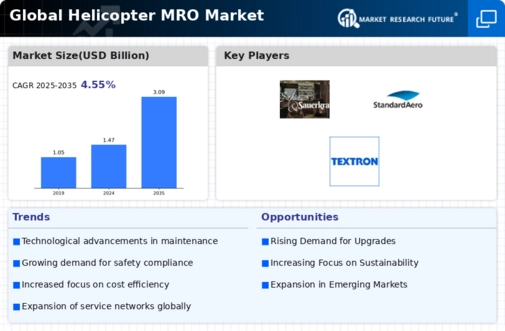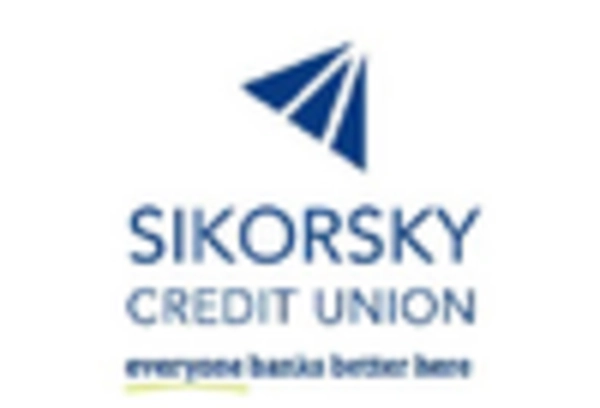-
EXECUTIVE SUMMARY
-
MARKET ATTRACTIVENESS ANALYSIS
- GLOBAL HELICOPTER MRO MARKET, BY TYPE
- GLOBAL HELICOPTER MRO MARKET, BY HELICOPTER TYPE
- GLOBAL HELICOPTER MRO MARKET, BY APPLICATION
- GLOBAL HELICOPTER MRO MARKET, BY REGION
-
MARKET INTRODUCTION
-
DEFINITION
-
SCOPE OF THE STUDY
-
RESEARCH OBJECTIVE
-
MARKET STRUCTURE
-
KEY BUYING CRITERIA
-
RESEARCH METHODOLOGY
-
RESEARCH PROCESS
-
PRIMARY RESEARCH
-
SECONDARY RESEARCH
-
MARKET SIZE ESTIMATION
-
FORECAST MODEL
-
LIST OF ASSUMPTIONS
-
MARKET INSIGHTS
-
MARKET DYNAMICS
-
INTRODUCTION
-
DRIVERS
- INCREASED USE OF COMMERCIAL HELICOPTERS
- GROWTH IN OUTSOURCING OF MRO SERVICES
- DRIVERS IMPACT ANALYSIS
-
RESTRAINTS
- ENVIRONMENTAL HAZARDS
- DEVELOPMENT OF NEXT-GENERATION HELICOPTERS
- RESTRAINTS IMPACT ANALYSIS
-
OPPORTUNITIES
- INTEGRATION OF INTERNET OF THINGS (IOT) IN MRO
-
TRENDS
- RISE IN 3D PRINTING OF COMPONENTS FOR HELICOPTER MRO
-
REGULATORY NORMS
-
MARKET FACTOR ANALYSIS
-
SUPPLY CHAIN ANALYSIS
- OEMS
- DISTRIBUTORS
- MAINTENANCE PROVIDERS
- PLATFORM
-
PORTER’S FIVE FORCES MODEL
- THREAT OF NEW ENTRANTS
- BARGAINING POWER OF SUPPLIERS
- BARGAINING POWER OF BUYERS
- THREAT OF SUBSTITUTES
- INTENSITY OF RIVALRY
-
GLOBAL HELICOPTER MRO MARKET, BY TYPE
-
OVERVIEW
-
GLOBAL HELICOPTER MRO MARKET, BY TYPE, 2020–2030 (USD MILLION)
-
AIRFRAME HEAVY MAINTENANCE
- AIRFRAME HEAVY MAINTENANCE: MARKET ESTIMATES & FORECAST, 2020–2030 (USD MILLION)
- AIRFRAME HEAVY MAINTENANCE: MARKET ESTIMATES & FORECAST, BY REGION, 2020–2030 (USD MILLION)
-
ENGINE MAINTENANCE
- ENGINE MAINTENANCE: MARKET ESTIMATES & FORECAST, 2020–2030(USD MILLION)
- ENGINE MAINTENANCE: MARKET ESTIMATES & FORECAST, BY REGION, 2020–2030 (USD MILLION)
-
COMPONENT MAINTENANCE
- COMPONENT MAINTENANCE: MARKET ESTIMATES & FORECAST, 2020–2030(USD MILLION)
- COMPONENT MAINTENANCE: MARKET ESTIMATES & FORECAST, BY REGION, 2020–2030 (USD MILLION)
-
LINE MAINTENANCE
- LINE MAINTENANCE: MARKET ESTIMATES & FORECAST, 2020–2030(USD MILLION)
- LINE MAINTENANCE: MARKET ESTIMATES & FORECAST, BY REGION, 2020–2030 (USD MILLION)
-
GLOBAL HELICOPTER MRO MARKET, BY HELICOPTER TYPE
-
OVERVIEW
-
GLOBAL HELICOPTER MRO MARKET, BY HELICOPTER TYPE, 2020–2030 (USD MILLION)
-
LIGHT HELICOPTER (9.0 TONS)
- HEAVY HELICOPTER (>9.0 TONS): MARKET ESTIMATES & FORECAST, 2020–2030 (USD MILLION)
- HEAVY HELICOPTER (>9.0 TONS): MARKET ESTIMATES & FORECAST, BY REGION, 2020–2030 (USD MILLION)
-
GLOBAL HELICOPTER MRO MARKET, BY APPLICATION
-
OVERVIEW
-
GLOBAL HELICOPTER MRO MARKET, BY APPLICATION, 2020–2030 (USD MILLION)
-
CIVIL
- CIVIL: MARKET ESTIMATES & FORECAST, 2020–2030(USD MILLION)
- CIVIL: MARKET ESTIMATES & FORECAST, BY REGION, 2020–2030 (USD MILLION)
-
MILITARY
- MILITARY: MARKET ESTIMATES & FORECAST, 2020–2030(USD MILLION)
- MILITARY: MARKET ESTIMATES & FORECAST, BY REGION, 2020–2030 (USD MILLION)
-
GLOBAL HELICOPTER MRO MARKET, BY REGION
-
OVERVIEW
- GLOBAL HELICOPTER MRO MARKET, BY REGION, 2020–2030 (USD MILLION)
-
NORTH AMERICA
- NORTH AMERICA: HELICOPTER MRO MARKET, 2020–2030 (USD MILLION)
- NORTH AMERICA: HELICOPTER MRO MARKET, BY COUNTRY, 2020–2030 (USD MILLION)
- NORTH AMERICA: HELICOPTER MRO MARKET, BY TYPE, 2020–2030 (USD MILLION)
- NORTH AMERICA: HELICOPTER MRO MARKET, BY HELICOPTER TYPE, 2020–2030 (USD MILLION)
- NORTH AMERICA: HELICOPTER MRO MARKET, BY APPLICATION, 2020–2030 (USD MILLION)
- US
- CANADA
-
EUROPE
- EUROPE: HELICOPTER MRO MARKET, 2020–2030 (USD MILLION)
- EUROPE: HELICOPTER MRO MARKET, BY COUNTRY, 2020–2030 (USD MILLION)
- EUROPE: HELICOPTER MRO MARKET, BY TYPE, 2020–2030 (USD MILLION)
- EUROPE: HELICOPTER MRO MARKET, BY HELICOPTER TYPE, 2020–2030 (USD MILLION)
- EUROPE: HELICOPTER MRO MARKET, BY APPLICATION, 2020–2030 (USD MILLION)
- UK
- GERMANY
- FRANCE
- ITALY
- RUSSIA
- REST OF EUROPE
-
ASIA-PACIFIC
- ASIA-PACIFIC: HELICOPTER MRO MARKET, 2020–2030 (USD MILLION)
- ASIA-PACIFIC: HELICOPTER MRO MARKET, BY COUNTRY, 2020–2030 (USD MILLION)
- ASIA-PACIFIC: HELICOPTER MRO MARKET, BY TYPE, 2020–2030 (USD MILLION)
- ASIA-PACIFIC: HELICOPTER MRO MARKET, BY HELICOPTER TYPE, 2020–2030 (USD MILLION)
- ASIA-PACIFIC: HELICOPTER MRO MARKET, BY APPLICATION, 2020–2030 (USD MILLION)
- CHINA
- JAPAN
- INDIA
- AUSTRALIA
- SOUTH KOREA
- REST OF ASIA-PACIFIC
-
MIDDLE EAST & AFRICA
- MIDDLE EAST & AFRICA: HELICOPTER MRO MARKET, 2020–2030 (USD MILLION)
- MIDDLE EAST & AFRICA: HELICOPTER MRO MARKET, BY COUNTRY, 2020–2030 (USD MILLION)
- MIDDLE EAST & AFRICA: HELICOPTER MRO MARKET, BY TYPE, 2020–2030 (USD MILLION)
- MIDDLE EAST & AFRICA: HELICOPTER MRO MARKET, BY HELICOPTER TYPE, 2020–2030 (USD MILLION)
- MIDDLE EAST & AFRICA: HELICOPTER MRO MARKET, BY APPLICATION, 2020–2030 (USD MILLION)
- SAUDI ARABIA
- UAE
- REST OF THE MIDDLE EAST & AFRICA
-
LATIN AMERICA
- LATIN AMERICA: HELICOPTER MRO MARKET, 2020–2030 (USD MILLION)
- LATIN AMERICA: HELICOPTER MRO MARKET, BY COUNTRY, 2020–2030 (USD MILLION)
- LATIN AMERICA: HELICOPTER MRO MARKET, BY TYPE, 2020–2030 (USD MILLION)
- LATIN AMERICA: HELICOPTER MRO MARKET, BY HELICOPTER TYPE, 2020–2030 (USD MILLION)
- LATIN AMERICA: HELICOPTER MRO MARKET, BY APPLICATION, 2020–2030 (USD MILLION)
- BRAZIL
- REST OF LATIN AMERICA
-
COMPETITIVE LANDSCAPE
-
COMPETITIVE OVERVIEW
-
COMPETITIVE BENCHMARKING
-
MARKET SHARE ANALYSIS
-
MAJOR GROWTH STRATEGIES IN THE GLOBAL HELICOPTER MRO MARKET
-
LEADING PLAYERS IN TERMS OF NUMBER OF DEVELOPMENTS IN THE GLOBAL HELICOPTER MRO MARKET
-
KEY DEVELOPMENTS & GROWTH STRATEGIES
- CONTRACTS & AGREEMENTS
- INVESTMENTS
- MERGERS & ACQUISITIONS
- PARTNERSHIPS, COLLABORATIONS, AND EXPANSIONS
-
COMPANY PROFILES
-
AIRBUS SAS
- COMPANY OVERVIEW
- FINANCIAL OVERVIEW
- PRODUCTS/SERVICES OFFERED
- KEY DEVELOPMENTS
- SWOT ANALYSIS
- KEY STRATEGIES
-
HELI-ONE
- COMPANY OVERVIEW
- FINANCIAL OVERVIEW
- PRODUCTS/SERVICES OFFERED
- KEY DEVELOPMENTS
- SWOT ANALYSIS
- KEY STRATEGIES
-
HONEYWELL INTERNATIONAL INC.
- COMPANY OVERVIEW
- FINANCIAL OVERVIEW
- PRODUCTS/SERVICES OFFERED
- KEY DEVELOPMENTS
- SWOT ANALYSIS
- KEY STRATEGIES
-
LEONARDO SPA
- COMPANY OVERVIEW
- FINANCIAL OVERVIEW
- PRODUCTS/SERVICES OFFERED
- KEY DEVELOPMENTS
- SWOT ANALYSIS
- KEY STRATEGIES
-
MTU AERO ENGINES AG
- COMPANY OVERVIEW
- FINANCIAL OVERVIEW
- PRODUCTS/SERVICES OFFERED
- KEY DEVELOPMENTS
- SWOT ANALYSIS
- KEY STRATEGIES
-
ROLLS-ROYCE HOLDINGS PLC
- COMPANY OVERVIEW
- FINANCIAL OVERVIEW
- PRODUCTS/SERVICES OFFERED
- KEY DEVELOPMENTS
- SWOT ANALYSIS
- KEY STRATEGIES
-
SAFRAN SA
- COMPANY OVERVIEW
- FINANCIAL OVERVIEW
- PRODUCTS/SERVICES OFFERED
- KEY DEVELOPMENTS
- SWOT ANALYSIS
- KEY STRATEGIES
-
STANDARDAERO
- COMPANY OVERVIEW
- FINANCIAL OVERVIEW
- PRODUCTS/SERVICES OFFERED
- KEY DEVELOPMENTS
- SWOT ANALYSIS
- KEY STRATEGIES
-
TEXTRON INC.
- COMPANY OVERVIEW
- FINANCIAL OVERVIEW
- PRODUCTS/SERVICES OFFERED
- KEY DEVELOPMENTS
- SWOT ANALYSIS
- KEY STRATEGIES
-
UNITED TECHNOLOGIES CORPORATION
- COMPANY OVERVIEW
- FINANCIAL OVERVIEW
- PRODUCTS/SERVICES OFFERED
- KEY DEVELOPMENTS
- SWOT ANALYSIS
- KEY STRATEGIES
-
OTHER PROMINENT PLAYERS IN THE MARKET
-
MID-CANADA MOD CENTER
-
ROBINSON HELICOPTER COMPANY
-
RUAG GROUP
-
RUSSIAN НELICOPTERS, JSC
-
APPENDIX
-
REFERENCES
-
RELATED REPORTS
-
LIST OF ABBREVIATION
-
LIST OF TABLES
-
PRIMARY INTERVIEWS
-
LIST OF ASSUMPTIONS
-
GLOBAL HELICOPTER MRO MARKET, BY TYPE, 2020–2030 (USD MILLION)
-
AIRFRAME HEAVY MAINTENANCE: MARKET ESTIMATES & FORECAST, 2020–2030 (USD MILLION)
-
AIRFRAME HEAVY MAINTENANCE: MARKET ESTIMATES & FORECAST, BY REGION, 2020–2030 (USD MILLION)
-
ENGINE MAINTENANCE: MARKET ESTIMATES & FORECAST, 2020–2030 (USD MILLION)
-
ENGINE MAINTENANCE: MARKET ESTIMATES & FORECAST, BY REGION, 2020–2030 (USD MILLION)
-
COMPONENT MAINTENANCE: MARKET ESTIMATES & FORECAST, 2020–2030 (USD MILLION)
-
COMPONENT MAINTENANCE: MARKET ESTIMATES & FORECAST, BY REGION, 2020–2030 (USD MILLION)
-
LINE MAINTENANCE: MARKET ESTIMATES & FORECAST, 2020–2030 (USD MILLION)
-
LINE MAINTENANCE: MARKET ESTIMATES & FORECAST, BY REGION, 2020–2030 (USD MILLION)
-
GLOBAL HELICOPTER MRO MARKET, BY HELICOPTER TYPE, 2020–2030 (USD MILLION)
-
LIGHT HELICOPTER (9.0 TONS): MARKET ESTIMATES & FORECAST, 2020–2030 (USD MILLION)
-
HEAVY HELICOPTER (>9.0 TONS): MARKET ESTIMATES & FORECAST, BY REGION, 2020–2030 (USD MILLION)
-
GLOBAL HELICOPTER MRO MARKET, BY APPLICATION, 2020–2030 (USD MILLION)
-
CIVIL: MARKET ESTIMATES & FORECAST, 2020–2030 (USD MILLION)
-
CIVIL: MARKET ESTIMATES & FORECAST, BY REGION, 2020–2030 (USD MILLION)
-
MILITARY: MARKET ESTIMATES & FORECAST, 2020–2030 (USD MILLION)
-
MILITARY: MARKET ESTIMATES & FORECAST, BY REGION, 2020–2030 (USD MILLION)
-
GLOBAL HELICOPTER MRO MARKET, BY REGION, 2020–2030 (USD MILLION)
-
NORTH AMERICA: HELICOPTER MRO MARKET, 2020–2030 (USD MILLION)
-
NORTH AMERICA: HELICOPTER MRO MARKET, BY COUNTRY, 2020–2030 (USD MILLION)
-
NORTH AMERICA: HELICOPTER MRO MARKET, BY TYPE, 2020–2030 (USD MILLION)
-
NORTH AMERICA: HELICOPTER MRO MARKET, BY HELICOPTER TYPE, 2020–2030 (USD MILLION)
-
NORTH AMERICA: HELICOPTER MRO MARKET, BY APPLICATION, 2020–2030 (USD MILLION)
-
US: HELICOPTER MRO MARKET, 2020–2030 (USD MILLION)
-
US: HELICOPTER MRO MARKET, BY TYPE, 2020–2030 (USD MILLION)
-
US: HELICOPTER MRO MARKET, BY HELICOPTER TYPE, 2020–2030 (USD MILLION)
-
US: HELICOPTER MRO MARKET, BY APPLICATION, 2020–2030 (USD MILLION)
-
CANADA: HELICOPTER MRO MARKET, 2020–2030 (USD MILLION)
-
CANADA: HELICOPTER MRO MARKET, BY TYPE, 2020–2030 (USD MILLION)
-
CANADA: HELICOPTER MRO MARKET, BY HELICOPTER TYPE, 2020–2030 (USD MILLION)
-
CANADA: HELICOPTER MRO MARKET, BY APPLICATION, 2020–2030 (USD MILLION)
-
EUROPE: HELICOPTER MRO MARKET, 2020–2030 (USD MILLION)
-
EUROPE: HELICOPTER MRO MARKET, BY COUNTRY, 2020–2030 (USD MILLION)
-
EUROPE: HELICOPTER MRO MARKET, BY TYPE, 2020–2030 (USD MILLION)
-
EUROPE: HELICOPTER MRO MARKET, BY HELICOPTER TYPE, 2020–2030 (USD MILLION)
-
EUROPE: HELICOPTER MRO MARKET, BY APPLICATION, 2020–2030 (USD MILLION)
-
UK: HELICOPTER MRO MARKET, 2020–2030 (USD MILLION)
-
UK: HELICOPTER MRO MARKET, BY TYPE, 2020–2030 (USD MILLION)
-
UK: HELICOPTER MRO MARKET, BY HELICOPTER TYPE, 2020–2030 (USD MILLION)
-
UK: HELICOPTER MRO MARKET, BY APPLICATION, 2020–2030 (USD MILLION)
-
GERMANY: HELICOPTER MRO MARKET, 2020–2030 (USD MILLION)
-
GERMANY: HELICOPTER MRO MARKET, BY TYPE, 2020–2030 (USD MILLION)
-
GERMANY: HELICOPTER MRO MARKET, BY HELICOPTER TYPE, 2020–2030 (USD MILLION)
-
GERMANY: HELICOPTER MRO MARKET, BY APPLICATION, 2020–2030 (USD MILLION)
-
FRANCE: HELICOPTER MRO MARKET, 2020–2030 (USD MILLION)
-
FRANCE: HELICOPTER MRO MARKET, BY TYPE, 2020–2030 (USD MILLION)
-
FRANCE: HELICOPTER MRO MARKET, BY HELICOPTER TYPE, 2020–2030 (USD MILLION)
-
FRANCE: HELICOPTER MRO MARKET, BY APPLICATION, 2020–2030 (USD MILLION)
-
ITALY: HELICOPTER MRO MARKET, 2020–2030 (USD MILLION)
-
ITALY: HELICOPTER MRO MARKET, BY TYPE, 2020–2030 (USD MILLION)
-
ITALY: HELICOPTER MRO MARKET, BY HELICOPTER TYPE, 2020–2030 (USD MILLION)
-
ITALY: HELICOPTER MRO MARKET, BY APPLICATION, 2020–2030 (USD MILLION)
-
RUSSIA: HELICOPTER MRO MARKET, 2020–2030 (USD MILLION)
-
RUSSIA: HELICOPTER MRO MARKET, BY TYPE, 2020–2030 (USD MILLION)
-
RUSSIA: HELICOPTER MRO MARKET, BY HELICOPTER TYPE, 2020–2030 (USD MILLION)
-
RUSSIA: HELICOPTER MRO MARKET, BY APPLICATION, 2020–2030 (USD MILLION)
-
REST OF EUROPE: HELICOPTER MRO MARKET, 2020–2030 (USD MILLION)
-
REST OF EUROPE: HELICOPTER MRO MARKET, BY TYPE, 2020–2030 (USD MILLION)
-
REST OF EUROPE: HELICOPTER MRO MARKET, BY HELICOPTER TYPE, 2020–2030 (USD MILLION)
-
REST OF EUROPE: HELICOPTER MRO MARKET, BY APPLICATION, 2020–2030 (USD MILLION)
-
ASIA-PACIFIC: HELICOPTER MRO MARKET, 2020–2030 (USD MILLION)
-
ASIA-PACIFIC: HELICOPTER MRO MARKET, BY COUNTRY, 2020–2030 (USD MILLION)
-
ASIA-PACIFIC: HELICOPTER MRO MARKET, BY TYPE, 2020–2030 (USD MILLION)
-
ASIA-PACIFIC: HELICOPTER MRO MARKET, BY HELICOPTER TYPE, 2020–2030 (USD MILLION)
-
ASIA-PACIFIC: HELICOPTER MRO MARKET, BY APPLICATION, 2020–2030 (USD MILLION)
-
CHINA: HELICOPTER MRO MARKET, 2020–2030 (USD MILLION)
-
CHINA: HELICOPTER MRO MARKET, BY TYPE, 2020–2030 (USD MILLION)
-
CHINA: HELICOPTER MRO MARKET, BY HELICOPTER TYPE, 2020–2030 (USD MILLION)
-
CHINA: HELICOPTER MRO MARKET, BY APPLICATION, 2020–2030 (USD MILLION)
-
JAPAN: HELICOPTER MRO MARKET, 2020–2030 (USD MILLION)
-
JAPAN: HELICOPTER MRO MARKET, BY TYPE, 2020–2030 (USD MILLION)
-
JAPAN: HELICOPTER MRO MARKET, BY HELICOPTER TYPE, 2020–2030 (USD MILLION)
-
JAPAN: HELICOPTER MRO MARKET, BY APPLICATION, 2020–2030 (USD MILLION)
-
INDIA: HELICOPTER MRO MARKET, 2020–2030 (USD MILLION)
-
INDIA: HELICOPTER MRO MARKET, BY TYPE, 2020–2030 (USD MILLION)
-
INDIA: HELICOPTER MRO MARKET, BY HELICOPTER TYPE, 2020–2030 (USD MILLION)
-
INDIA: HELICOPTER MRO MARKET, BY APPLICATION, 2020–2030 (USD MILLION)
-
AUSTRALIA: HELICOPTER MRO MARKET, 2020–2030 (USD MILLION)
-
AUSTRALIA: HELICOPTER MRO MARKET, BY TYPE, 2020–2030 (USD MILLION)
-
AUSTRALIA: HELICOPTER MRO MARKET, BY HELICOPTER TYPE, 2020–2030 (USD MILLION)
-
AUSTRALIA: HELICOPTER MRO MARKET, BY APPLICATION, 2020–2030 (USD MILLION)
-
SOUTH KOREA: HELICOPTER MRO MARKET, 2020–2030 (USD MILLION)
-
SOUTH KOREA: HELICOPTER MRO MARKET, BY TYPE, 2020–2030 (USD MILLION)
-
SOUTH KOREA: HELICOPTER MRO MARKET, BY HELICOPTER TYPE, 2020–2030 (USD MILLION)
-
SOUTH KOREA: HELICOPTER MRO MARKET, BY APPLICATION, 2020–2030 (USD MILLION)
-
REST OF ASIA-PACIFIC: HELICOPTER MRO MARKET, 2020–2030 (USD MILLION)
-
REST OF ASIA-PACIFIC: HELICOPTER MRO MARKET, BY TYPE, 2020–2030 (USD MILLION)
-
REST OF ASIA-PACIFIC: HELICOPTER MRO MARKET, BY HELICOPTER TYPE, 2020–2030 (USD MILLION)
-
REST OF ASIA-PACIFIC: HELICOPTER MRO MARKET, BY APPLICATION, 2020–2030 (USD MILLION)
-
MIDDLE EAST & AFRICA: HELICOPTER MRO MARKET, 2020–2030 (USD MILLION)
-
MIDDLE EAST & AFRICA: HELICOPTER MRO MARKET, BY COUNTRY, 2020–2030 (USD MILLION)
-
MIDDLE EAST & AFRICA: HELICOPTER MRO MARKET, BY TYPE, 2020–2030 (USD MILLION)
-
MIDDLE EAST & AFRICA: HELICOPTER MRO MARKET, BY HELICOPTER TYPE, 2020–2030 (USD MILLION)
-
MIDDLE EAST & AFRICA: HELICOPTER MRO MARKET, BY APPLICATION, 2020–2030 (USD MILLION)
-
SAUDI ARABIA: HELICOPTER MRO MARKET, 2020–2030 (USD MILLION)
-
SAUDI ARABIA: HELICOPTER MRO MARKET, BY TYPE, 2020–2030 (USD MILLION)
-
SAUDI ARABIA: HELICOPTER MRO MARKET, BY HELICOPTER TYPE, 2020–2030 (USD MILLION)
-
SAUDI ARABIA: HELICOPTER MRO MARKET, BY APPLICATION, 2020–2030 (USD MILLION)
-
UAE: HELICOPTER MRO MARKET, 2020–2030 (USD MILLION)
-
UAE: HELICOPTER MRO MARKET, BY TYPE, 2020–2030 (USD MILLION)
-
UAE: HELICOPTER MRO MARKET, BY HELICOPTER TYPE, 2020–2030 (USD MILLION)
-
UAE: HELICOPTER MRO MARKET, BY APPLICATION, 2020–2030 (USD MILLION)
-
REST OF THE MIDDLE EAST & AFRICA: HELICOPTER MRO MARKET, 2020–2030 (USD MILLION)
-
REST OF THE MIDDLE EAST & AFRICA: HELICOPTER MRO MARKET, BY TYPE, 2020–2030 (USD MILLION)
-
REST OF THE MIDDLE EAST & AFRICA: HELICOPTER MRO MARKET, BY HELICOPTER TYPE, 2020–2030 (USD MILLION)
-
REST OF THE MIDDLE EAST & AFRICA: HELICOPTER MRO MARKET, BY APPLICATION, 2020–2030 (USD MILLION)
-
LATIN AMERICA: HELICOPTER MRO MARKET, 2020–2030 (USD MILLION)
-
LATIN AMERICA: HELICOPTER MRO MARKET, BY COUNTRY, 2020–2030 (USD MILLION)
-
LATIN AMERICA: HELICOPTER MRO MARKET, BY TYPE, 2020–2030 (USD MILLION)
-
LATIN AMERICA: HELICOPTER MRO MARKET, BY HELICOPTER TYPE, 2020–2030 (USD MILLION)
-
LATIN AMERICA: HELICOPTER MRO MARKET, BY APPLICATION, 2020–2030 (USD MILLION)
-
BRAZIL: HELICOPTER MRO MARKET, 2020–2030 (USD MILLION)
-
BRAZIL: HELICOPTER MRO MARKET, BY TYPE, 2020–2030 (USD MILLION)
-
BRAZIL: HELICOPTER MRO MARKET, BY HELICOPTER TYPE, 2020–2030 (USD MILLION)
-
BRAZIL: HELICOPTER MRO MARKET, BY APPLICATION, 2020–2030 (USD MILLION)
-
REST OF LATIN AMERICA: HELICOPTER MRO MARKET, 2020–2030 (USD MILLION)
-
REST OF LATIN AMERICA: HELICOPTER MRO MARKET, BY TYPE, 2020–2030 (USD MILLION)
-
REST OF LATIN AMERICA: HELICOPTER MRO MARKET, BY HELICOPTER TYPE, 2020–2030 (USD MILLION)
-
REST OF LATIN AMERICA: HELICOPTER MRO MARKET, BY APPLICATION, 2020–2030 (USD MILLION)
-
THE MOST ACTIVE PLAYERS IN THE GLOBAL HELICOPTER MRO MARKET
-
CONTRACTS & AGREEMENTS
-
INVESTMENTS
-
MERGERS & ACQUISITIONS
-
PARTNERSHIPS, COLLABORATIONS, AND EXPANSIONS
-
AIRBUS SAS: PRODUCTS/SERVICES OFFERED
-
AIRBUS SAS: KEY DEVELOPMENTS
-
HELI-ONE: PRODUCTS/SERVICES OFFERED
-
HONEYWELL INTERNATIONAL INC.: PRODUCTS/SERVICES OFFERED
-
LEONARDO SPA: PRODUCTS/SERVICES OFFERED
-
LEONARDO SPA: KEY DEVELOPMENTS
-
MTU AERO ENGINES AG: PRODUCTS/SERVICES OFFERED
-
ROLLS-ROYCE HOLDINGS PLC: PRODUCTS/SERVICES OFFERED
-
SAFRAN SA: PRODUCTS/SERVICES OFFERED
-
SAFRAN SA: KEY DEVELOPMENTS
-
STANDARDAERO: PRODUCTS/SERVICES OFFERED
-
STANDARDAERO: KEY DEVELOPMENTS
-
TEXTRON INC.: PRODUCTS/SERVICES OFFERED
-
UNITED TECHNOLOGIES CORPORATION: PRODUCTS/SERVICES OFFERED
-
MID-CANADA MOD CENTER: COMPANY OVERVIEW AND PRODUCTS/SERVICES OFFERED
-
ROBINSON HELICOPTER COMPANY: COMPANY OVERVIEW AND PRODUCTS/SERVICES OFFERED
-
RUAG GROUP: COMPANY OVERVIEW AND PRODUCTS/SERVICES OFFERED
-
RUSSIAN НELICOPTERS, JSC: COMPANY OVERVIEW AND PRODUCTS/SERVICES OFFERED
-
LIST OF FIGURES
-
MARKET SYNOPSIS
-
MARKET ATTRACTIVENESS ANALYSIS: GLOBAL HELICOPTER MRO MARKET
-
GLOBAL HELICOPTER MRO MARKET ANALYSIS, BY TYPE
-
GLOBAL HELICOPTER MRO MARKET ANALYSIS, BY HELI
-
"

















Leave a Comment